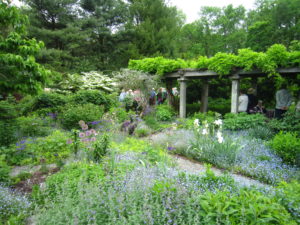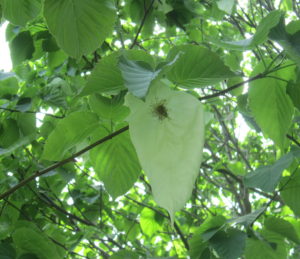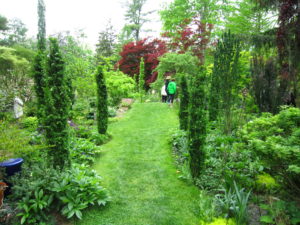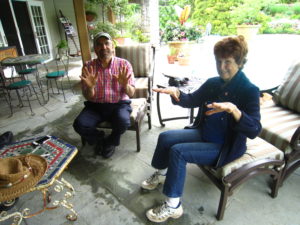Hello fellow readers, The Pennsylvania Horticultural Society (PHS) hosted a tour of two private gardens in Northwestern, NJ, and I had the joy of attending. A visit, if you will, with the two best gardeners of the garden state I have the privilege of knowing.
While I frequently savor a stroll among my friend and design colleague’s garden, this time, meandering grounds and gardens were especially glorious. Marty Carson’s unusual and pleasing plant combinations are meticulously maintained.
About Ken Druse and Marty Carson
Ken Druse, a well-known garden author, and photographer, joined the first leg of the PHS tour and shared the concern that his gardens, next in the queue, may not pass muster by comparison. This Spring’s plentiful moisture has indeed been pleasing for plants, especially weeds. We giggled, comparing gardening hands; both my friend’s and Ken’s equally worked.
“They’re here for you, Ken,” my colleague humbly said. While it’s true Ken Druse is nationally known, Marty’s design skills warrant her popularity and “fame,” though she prefers to remain anonymous. Her gardens grace the pages of two books: Great Houses and Gardens of New Jersey by Caroline Seebohm, 2003, and Gardens of the Garden State by Nancy Berner and Susan Lowry, 2014 also featuring Ken’s garden, a highly recommended read.
The Discovery of the Dove Tree
When I arrived, Ken was admiring the Davidia involucrata Baill, also known as Dove Tree, which was in bloom for the first time with pairs of white bracts that look like handkerchiefs or ghosts (the tree’s other common names) dancing upon the heart-shaped leaves.
It’s a finicky bloomer, often not fully hardy when young, and can take ten or twenty years to flower; perhaps why many garden gurus admire the Dove Tree.
The legend of its discovery and propagation reads like a thriller. Earnest Wilson, a young botanist, equipped with a hand-drawn map, rides the seas to China, almost drowns, escapes bandits, and survives diseases. Only to find the one known Dove Tree cut down to build a house. The happy ending – Wilson’s unyielding exploratory spirit succeeded in finding other trees whose seeds were brought back to England in 1901.
“This Garden is about Plants”
The next stop on tour was Ken’s garden and Louis Bauer’s garden, director of horticulture at Wave Hill. PHS’s promotion of the event describes, ‘Their rural garden, situated on a two-acre island, is home to a vast collection of specimen plants, some very rare, and all carefully chosen and sited to their best advantage.’
Ken cordially encouraged guests to meander but requested folks not to step back as narrow paths are winding throughout.
“This garden is about plants. And the goal is to fit as many in as possible,” Ken said. His beautifully designed garden is indeed a plant museum of sorts.
After relishing the gravel garden, a collection of columnar boxwood, Buxus sempervirens ‘Graham Blandy’ cleverly lassoed with yarn to exaggerate their svelteness, made a striking invitation to a charming stone bridge topped in turf leading to an alluring lawn embraced with glorious garden goodies.
Opening ones’ gardens to guests was a delightful gift these legendary gardeners provided. Their gardens are far better groomed than my own; a shoemaker with worn shoes, as the saying goes. One wonders how these cobblers find time to sew such magnificent shoes. Their compassion for plants has much to do with it.
Garden Dilemmas? AskMaryStone@gmail.com (and on your favorite Podcast App.)
Link to a previous story you’ll enjoy Extraoridanry Gardeners, Extraordinary Plants
Column updated 3/13/22
A few of the many plants in Ken’s garden especially admired:
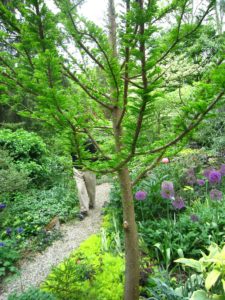
Taxodium distichum’ Peve Minaret’ / Peve Minaret Dwarf Bald Cypress
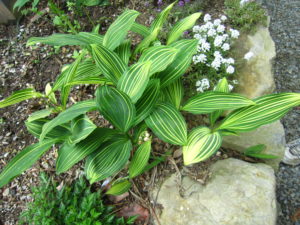
Convallaria majalis ‘Albostriata’ / Variegated Lily Of The Valley
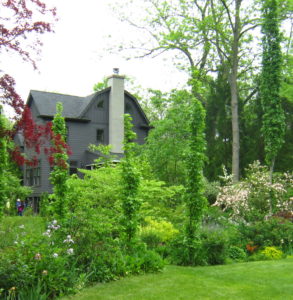
Acer saccharum ‘Newton Sentry’ / Newton Century Maple


